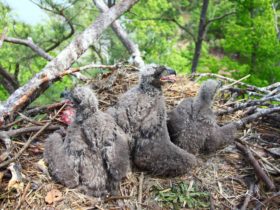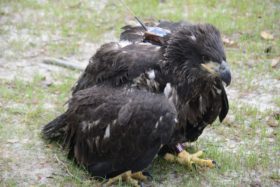Camellia Flies Further North
Catfish Pond Visit
July 16, 2010Azalea at Catfish Ponds During Visit July 15
July 20, 2010

Camellia continues his journey by flying further north and east into territory explored last year by his big sister, Azalea. Camellia left the Wise Point area about 10:00am July 16 flying over King and Queen County and just after noon reached the Rappahannock River and turned southeast. Just north of Urbanna in Middlesex County at just after 1:00pm Camellia crossed the Rappahannock into Lancaster County and by 3:00pm was at the shore of Chesapeake Bay where he turned north and flew to Mill Creek in Northumberland County. He remained here a few miles east of Mount Olive, VA for the next two nights. At about 11:00am yesterday July 18 he flew north just past Reedville and at noon did a U-turn and flew south past the mouth of the Great Wicomico River to about Kilmarnock and turned west back into Lancaster County. Camellia found a pond just west of Weems, VA that is north of Wharton Grove Rd and that is where he was last night and as of this map at 7:00am this morning July 19. Does Weems, VA sound familiar? Azalea was in this same area although not the same spot on October 28, 2009.




10 Comments
It all sounds very familiar–hope she sticks to a fish diet and doesn’t hang out at the landfills. Az must have sent him a signal!!
I hope one year we can see *two* eaglets from the same clutch with transmitters. I often wonder if siblings travel together or meet up in similar areas.
Be safe in your travels NC
mayb he is looking for his big sister? lol Miss Diva loves to wander,but she loves the catfish.im like someone said,mayb they are meeting up.lol cam please b safe.find the catfish hole . thanks again for the up dates,good job as always.
Thank you so much for keeping us updated on AZ and Cammy. It is heartwarming to know they are still going strong. It would be wonderful to know one day that maybe they meet up together. Thanks for all you do to allow us this opportunity.
Interesting that he seems to be on a very similar path as Azalea’s. Hope he doesn’t wander too far north. Stay safe Camellia! Come back soon.
Thanks for the updates. I miss seeing them on the cam!
Up until a couple of weeks ago, I was seeing one or two eaglets at a time around the river near the zoo nearly every day. I was out of town from the 7th through the 13th, and haven’t seen any since then. I guess they have all left the area for now.
I’m just glad Camellia has departed the airport!! Hope he stays well…
I guess since he’s flying so far and not coming back to NBG every day that we can assume that he’s managing to find food for himself?
Paula – Yes, since Camellia has been gone from the care of his parents for almost two weeks, I think we can assume that he is successfully foraging for food.